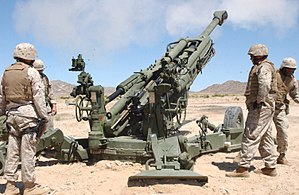
Back هاوتزر عيار 155 مم xm777 Arabic M777 Czech M777 German Obús M777 Spanish M777 Estonian M777 (haupitsi) Finnish M777 (canon d'artillerie) French M777 Croatian M777 Hungarian Մ777 հաուբից Armenian
| M777 Lightweight Towed Howitzer | |
|---|---|
 US Marine gunners test fire an M777 howitzer | |
| Type | Towed howitzer |
| Place of origin | United Kingdom |
| Service history | |
| In service | 2005–present |
| Used by | See Operators |
| Wars | |
| Production history | |
| Designer | Vickers Shipbuilding and Engineering |
| Designed | 1987–2003 |
| Manufacturer | BAE Systems |
| Produced | 1987–present |
| Specifications | |
| Mass | 4.2 t (4.1 long tons; 4.6 short tons)[6] |
| Length |
|
| Barrel length | 5.08 m (16.7 ft) L/39 |
| Crew | 7+1 |
| Shell | M107, M549, M712 Copperhead, M795, ERFB, M982 |
| Caliber | 155 mm (6.1 in)[7] |
| Carriage | Split trail |
| Elevation | 0° to +71.7°[8] |
| Rate of fire |
|
| Muzzle velocity | Charge 8S: 827 m/s (2,710 ft/s) |
| Effective firing range |
|
The M777 howitzer is a British towed 155 mm artillery piece in the howitzer class. It is used by the ground forces of Australia, Canada, Colombia, India, Saudi Arabia, Ukraine, and the United States. It was first used in combat during the War in Afghanistan.
The M777 is manufactured by BAE Systems' Global Combat Systems division. Prime contract management is based in Barrow-in-Furness in Cumbria, England, UK, as well as manufacture and assembly of the titanium structures and associated recoil components. Final integration and testing of the weapon is undertaken at BAE's facility in Hattiesburg, Mississippi, US.[10] Depending on the year, contract and systems package, the M777 has been exported for individual unit costs including US$2.025 million (in 2008) and $3.738 million (in 2017).[11][12]
- ^ "Artillery fire in Afghanistan (Pech river Valley) Taliban running scared!". YouTube. 11 May 2011. Archived from the original on 11 January 2017. Retrieved 11 June 2017.
- ^ "Rain Or Shine: Task Force Strike Artillerymen support Mosul counter-offensive". U.S. Central Command. CENTCOM.
- ^ "CENTCOM forces engage militants in northeast Syria" (Press release). CENTCOM.
- ^ "Yemen War 2015 - Saudi Arabian Artillery Fired At Houthi Rebels In Northern Yemen". WarLeaks. 14 April 2015. Archived from the original on 21 April 2015. Retrieved 11 June 2017 – via YouTube.
Alleged footage of an Saudi Arabian artillery launch on Houthi rebel positions in Northern Yemen.
- ^ "Canada delivers M777 howitzers to Ukraine". Ukrinform. 23 April 2022. Retrieved 23 April 2022.
- ^ U.S. Upgrades and Orders More Lightweight BAE Systems Howitzers, BAE Systems, archived from the original on 10 July 2015, retrieved 9 July 2015
- ^ "M777 Lightweight Towed 155mm Howitzer". BAE Systems.
- ^ Pike, John. "M777 Lightweight 155mm howitzer (LW155)". Global security. Archived from the original on 4 November 2014. Retrieved 4 November 2014.
- ^ "Excalibur Projectile". What we do. Raytheon missiles & defense.
- ^ "U.S. Upgrades and Orders More Lightweight BAE Systems Howitzers" (Press release). USA: BAE Systems. 5 September 2011. Archived from the original on 21 April 2021. Retrieved 26 June 2022.
- ^ "CAST TITANIUM CUTS COST OF M777 LIGHTWEIGHT HOWITZER". Advanced Materials & Processes. Archived from the original on 21 June 2022. Retrieved 29 June 2022.
- ^ "Indian Army receives K9 Vajra and M777 howitzer weapon systems". 9 November 2018.